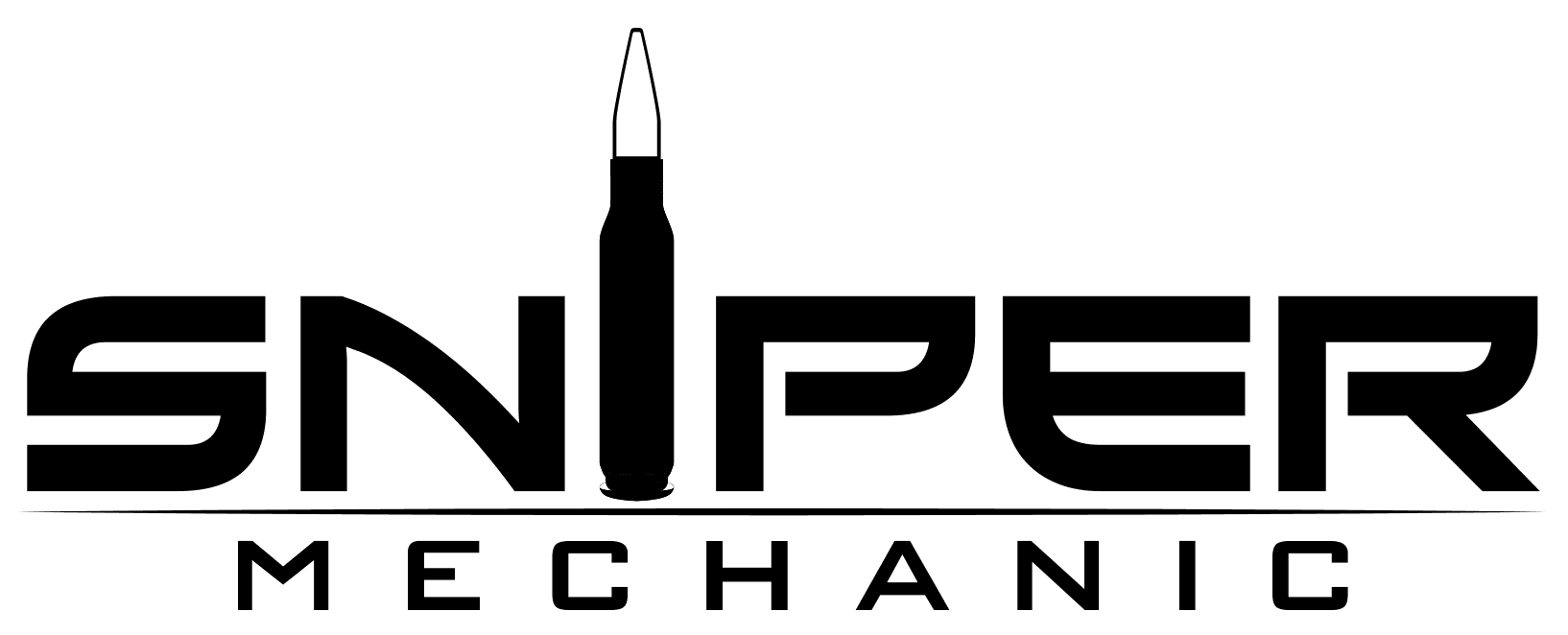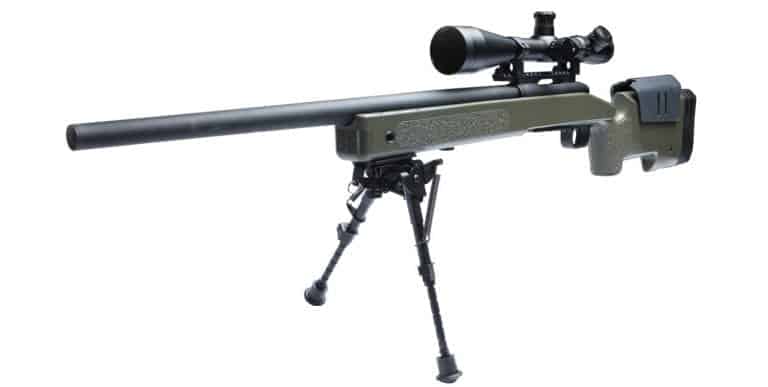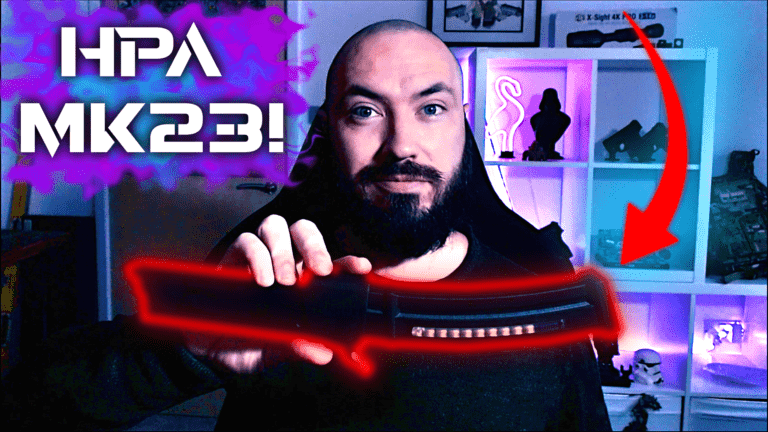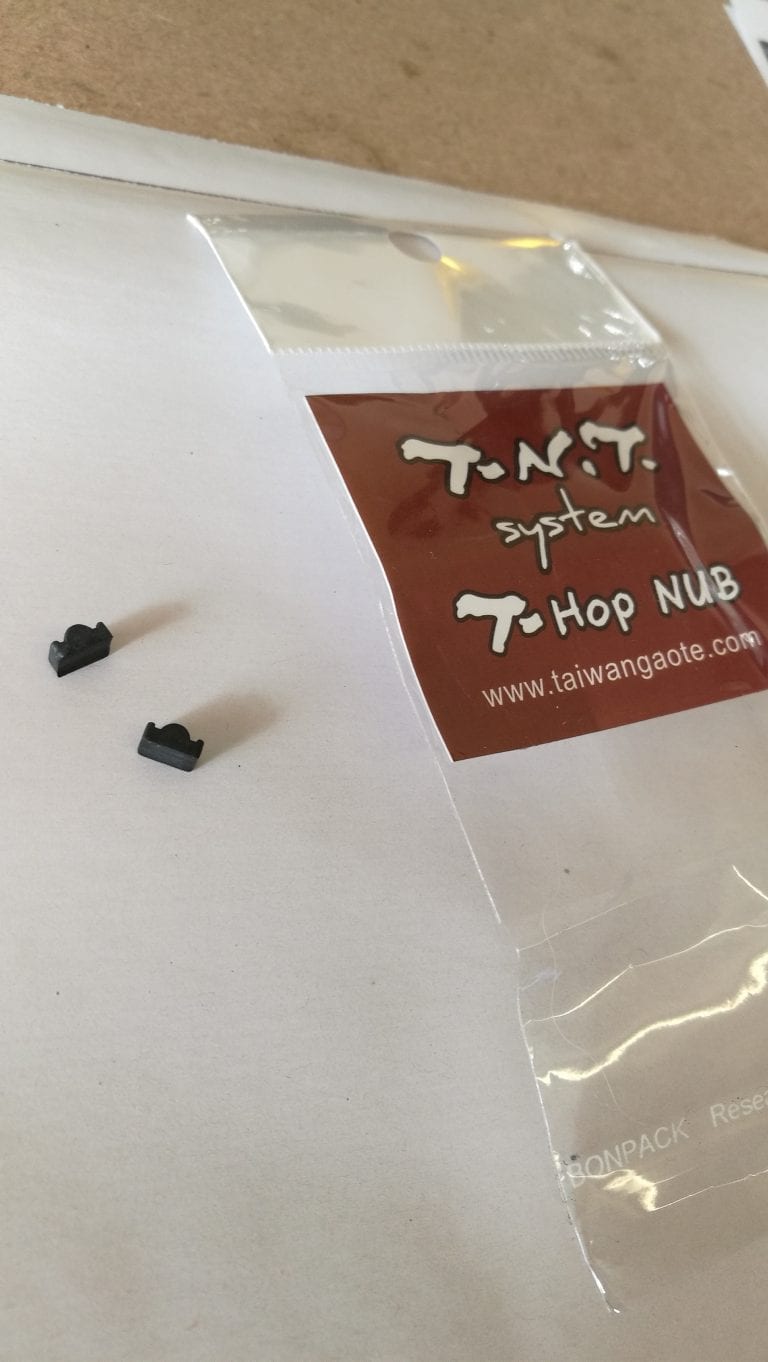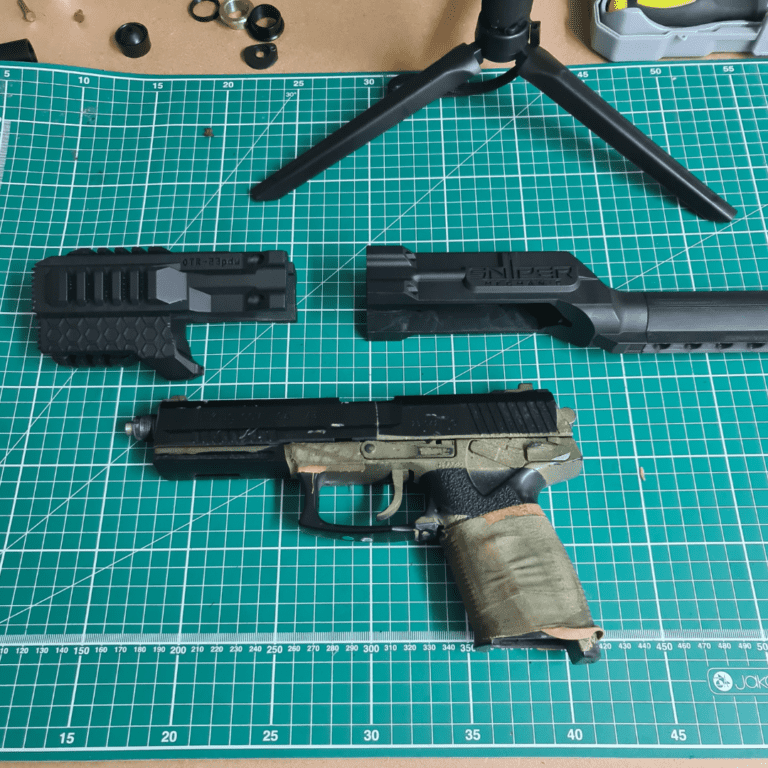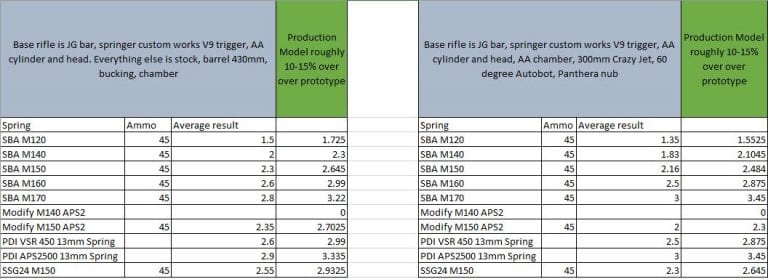Silverback SRS: The SniperMechanics Guide (ongoing/evolving)
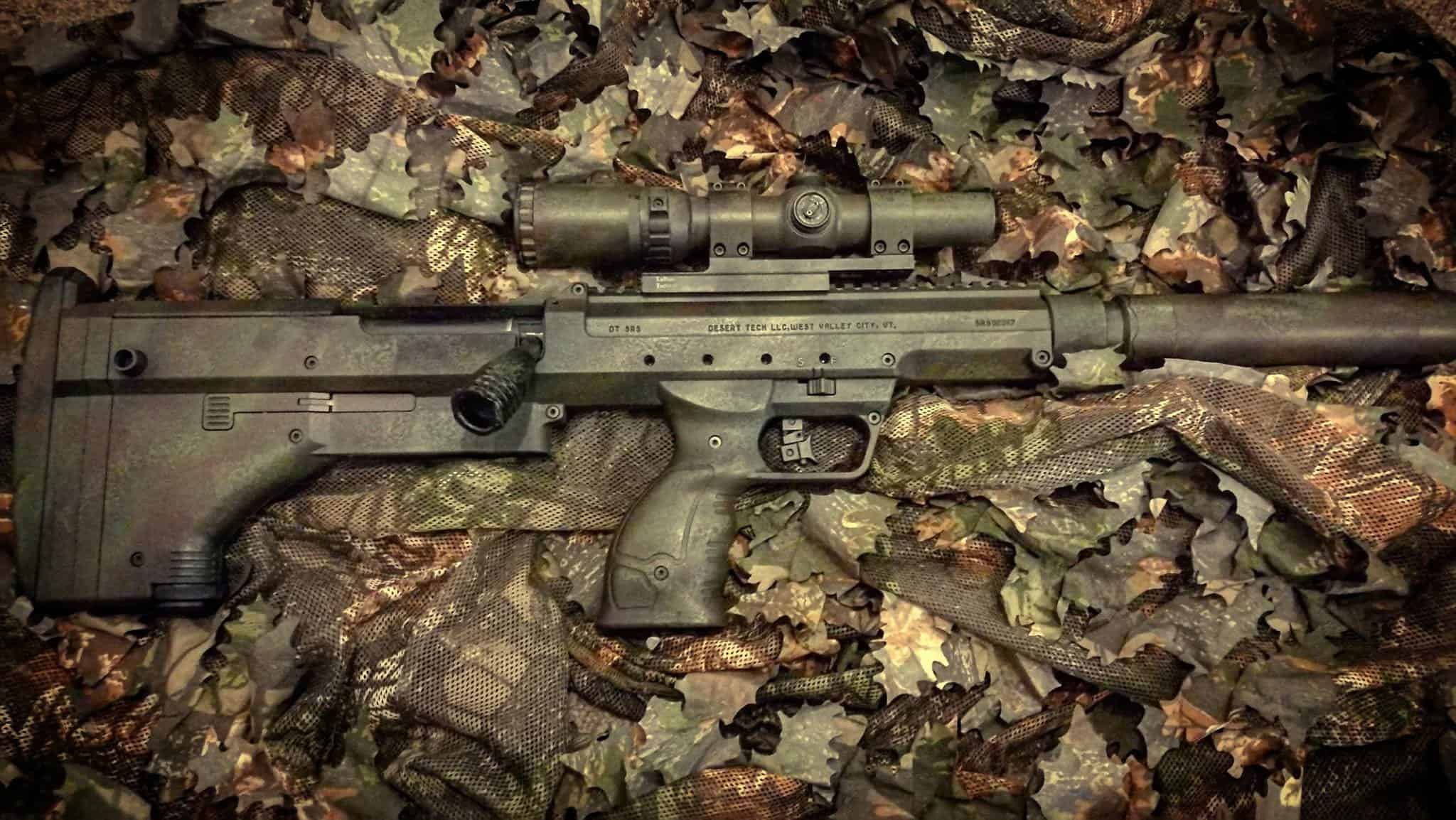
***Please note that “Silverback SRS Upgrades” post is is an ongoing post and will be continually updated with missing images/video
What is the SRS?
The Silverback SRS is a licenced Airsoft Replica based on the Desert Tech SRS-A1 series of rifles. Real steel history of the rifle can be found here:
Having been released on the 25th November 2015, the rifle has been met with positivity amongst the airsoft community, due to it’s great out of the box performance and overall build quality.
Initially released as a push bolt rifle, where the bolt was charged forward in order to cock, it was later released as a pull bolt version too, with both versions now sold.
The rifle comes in a variety of lengths and colours, including 16″/20″/22″/26″ and black, OD, FDE.
The rifle boasts a unique bullpup design, with some variants being as short as 56CM long while maintaining an inner barrel of 309mm.
The rifle uses proprietary parts for the most parts, but it does take some commercially available aftermarket parts such as:
13mm APS Style Springs for the pull version
AEG Style Springs for the push version
AEG Barrels
AEG Hop Rubbers
AEG piston head for the push version
The rifle has a cylinder volume of circa 41cc for the Pull Bolt and circa 28cc cubed for the push, which is huge compared to the more traditional VSR series of rifles.
This large air volume allows for much longer/wider barrels to be used and it great for shooting heavy ammo such as 48’s/5’s.
For the purpose of this guide, we’ll be looking at the more common pull bolt system as opposed to the push bolt, which will be added to this in the near future.
Silverback SRS Upgrades Section 1 – Basic Set Up
Once you’ve finished marvelling over the quality of the Silverback SRS in all it’s glory, you’ll want to take some time to get to know the rifle and clean/lube everything before assembling the rifle.
In the box you’ll get:
– Main Receiver
– 1 Magaziner
– Outer barrel (inner barrel and hop installed already)
– Piston
– Cylinder
– Spring guide
– Spring
– Rails 1-3 (depends on model)
– Monopod (depends on model) installed
– Bag of spares
– Buttpad
Step 1 – Clean your barrel
To do this remove the small grub screw from the top of the outer barrel, this will allow you to remove the stock hop unit form the outer barrel.
IMG hop unit top
Once you’ve done this, you will then want to remove the two small grub screws on either side of the hop unit, then slide the hop forward and off (depending on the generation of your rifle, you will need to remove the hop adjustment grub screws/thumbwheels before hand)
IMG Hop Unit Stock
IMG FAST Hop
Now you’ll want to remove the bucking, then you can go ahead and clean the inner barrel, I suggest isopropyl alcohol, on a cloth on a cleaning rod and just run it up and down, changing the cloth periodically until the cloth/tissues starts coming out clean.
With the barrel cleaned, you can now reinstall the hop rubber, making sure to use PTFE tape on the rear of the bucking where it meets the barrel. For more information on airseal mods, scroll down to section 2C.
When tightening the 2 retaining screws in the hop chamber, DO NOT OVERTIGHTENT THEM, doing so will damage the barrel as it will cause the barrel to pinch.
Once you have the hop unit all assembled, you’ll want to slide it into the outer barrel, ensureing it is lined up before securing it. you can then slide the outer barrel into the main receiver, ensure that the lock screws is set to the unlocked position.
With the outer barrel now in the receiver, you will need to ensure the lock nut is set into the lock position, then on the other side of the rifle, you will need to adjust the 4 securing screws, I suggested doing this from the rear to the front, then repeat until all screws are tightened and there is 0 barrel wobble. If you have a torque wrench, tighten all these screws at 8NM.
Step 2 – Piston/Cylinder internals
First things first, you will want to clean off any and all grease on the piston, piston oring, piston head air holes and cylinder.
IMG Piston
IMG Guide
IMG Cylinder
WIth everything cleaned off, put some silicon oil onto the piston o ring and also on the last half of the cylinder head nozzle, this ensure that the orings in the hop chamber are kept lubricated. DO NOT PUT ON THE END OF THE NOZZLE OTHERWISE IT WILL GET ON THE HOP RUBBER
At this stage I would cover the hop unit entrance and spray some Dry PTFE inside the receiver channel with the cylinder moves in order to help with a smoother operation.
Now you can install the piston into the cylinder and then holding down the trigger, you should be able to slide the cylinder into the receiver, then you can slide in the spring (stock or upgraded one) and spring guide, when inserting the spring guide, you will want to push it in alongside the spring into the receiver, then pushing the trigger forward, set the rifle to safe, if your sear height is set correct from the factory, this should keep all the internals in place which you slide on and secure the buttpad.
At this stage I suggest spraying some PTFE Dry Lube on the outside of the cylinder too.
Having now done all of the above, you’re ready to chrono the rifle and get the hop set for the ammo you’re using. If you’re using the stock chamber, then you can set the hop by evenly adusting the grubscrews/thumbwheels, on the FAST hop, you just turn the main wheel.
*Adjusting the hopup without the bolt assembly will allow you to visualize the hopup rubber deformation: be gentle with the standard hopup or you will jam the rifle quickly, and, in the worst case, destroy the rubber and expel the grub screws by the barrel!
Silverback SRS Upgrades Section 2 – DIY Mods
As with any airsoft rifle, there are always things that can be improved with some basic DIY mods which I will outline below and split into sections, some of these are easy enough for anyone, others required a bit more knowledge/tools:
Silverback SRS Upgrades Section 2A – Sound mods:
The main aim for this mods is to try to reduces as much as the mechanic noise/echo as possible, the first and most basic way of doing this is by simply finding any gaps and filling them with various kinds of foam, anything will do really.
The common areas to look at are around where the monopod is and also the buttpad spacers, as a lot of the noise is located at the rear of the rifle.
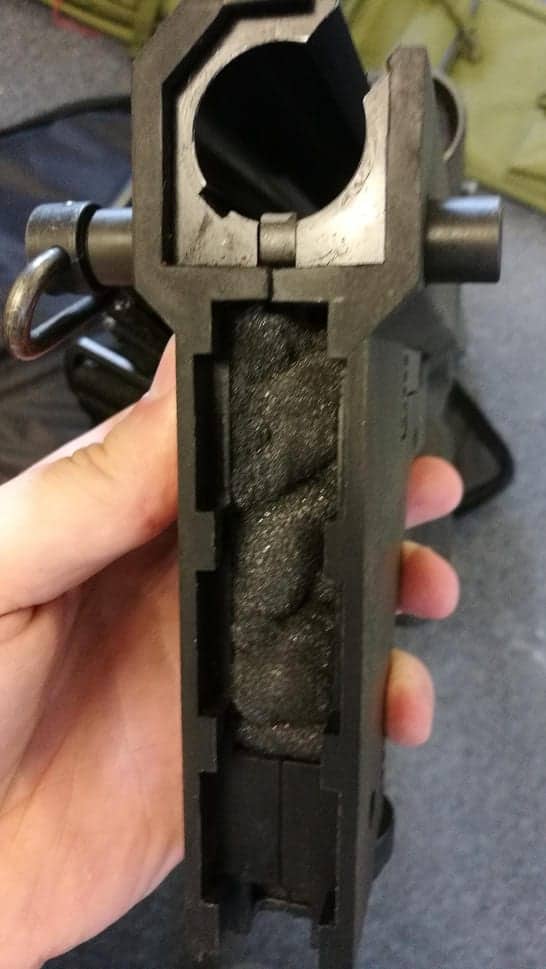
After doing this, you’ll want to address the spring/piston/guide noise on firing the rifle, this happens as the spring has room to move on the spring guide and inside, this small amount of room is enough for the spring to rattle/vibrate which can give the annoying twang sound. There are a few ways to tackle this:
1) use a piece of cut up can/thin plastic inside the piston
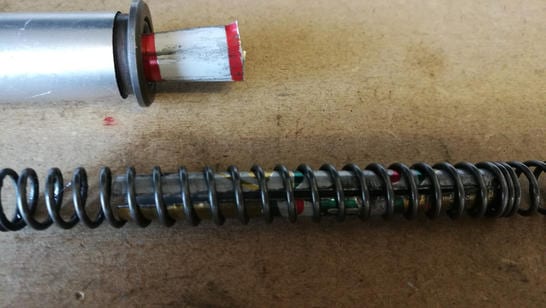
2) Use a piece of can/plastic/heat shrink on the spring guide, before you slide the spring over. In the pic mines seated inside the spring, as it was just removed.
Doing this reduces the amount of the room the spring has to move both inside the piston and on the spring guide, it serves another purpose too, which is that it keeps everything lined up when cocking the rifle, which helps with the bolt pull.
Another area where there is a lot of sound, is the spring guide base. When the rifle is fired, the spring guide base moves under the motion of the spring releasing, this causes it to “jump” inside the recess where it sits in the buttpad spacer. One of the biggest secrets to how I got my gspec set up so silent wasn’t just the W.A.S.P piston, it was how I worked on the spring guide.
What you’ll want to do is pack out the buttpad area with foam, then where the spring guide sits, you’ll want to use thin plastic/card/foam to make a “buffer cushion” for the spring guide to sit in, doing this means the guide only contacts the card/plastic buffer as opposed to the buttpad spacer, which greatly reduces sound. Additionally you’ll want to use electrical tape on the buttpad spacer for the same reason as above, you want to reduced hard plastic on metal contact as much as possible.
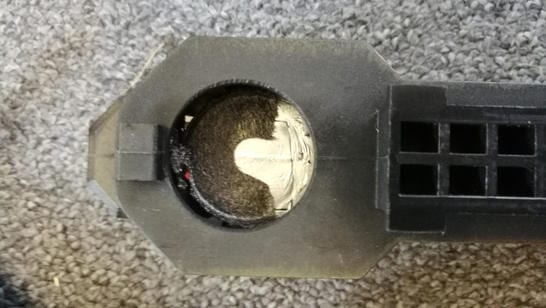
Silverback SRS Upgrades Section 2B – Smooth Bolt Mods:
Spring Guide
This mod was originally done by “The Gray Fox” and helps offer an incredible bolt pull. Rather than try to explain this one in writing, The Gray Fox has kindly provided a link to the video he did on FaceBook where he covers it.
https://m.facebook.com/story.php?story_fbid=1692363647495238&id=1640842132647390
Sear Spring – On some rifles the sear spring is to tough and makes the last cm of cocking the rifle difficult, you can either remove the spring entirely which some people have done or simply cut the spring spring by a few coils, or even use a spring form a pen. Doing this helps the piston slide over this seal easier.
Cylinder Nub Removal (pull bolt only) – This one is quite an easy one to do and simpy requires that you remove the lug of the cylinder head, and grind/sand it flush with the cylinder head. While this can help with the bolt pull, it does mean you lose the “guide” that the lug provides, so you need to ensure you cock the rifle correctly.
IMG Cylinder Head
Silverback SRS Upgrades Section 2C – AirSeal Mods:
PTFE/Silicon plaster- Whatever bucking you use, simply wrap the rear of the bucking with PTFE tape or if this doesn’t help with the seal, another great alternative (stumbled upon by my friend “Gunsmithy Airsoft”), is to use waterproof silicon plasters, cut off the sticky portion and wrap it round the end of the bucking and barrel. This can also be done if you’re using Rhop patches as an alternative to tape or glue.
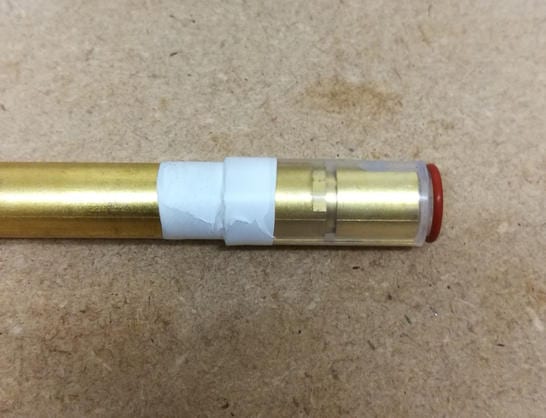
Oring Mod (Simon Choo) – This mod is another one to improve airseal and requires you to put a 7mm x 1mm oring over the feedlips of any given bucking prior to assembling, it can take some time to get right, but ensures the feed lips stay closed and no air is lossed from the front of the bucking, which is a common issue with both the stock and FAST hop units.
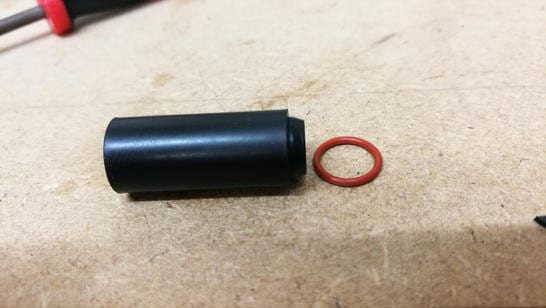
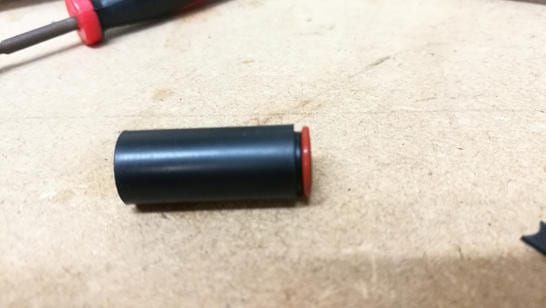
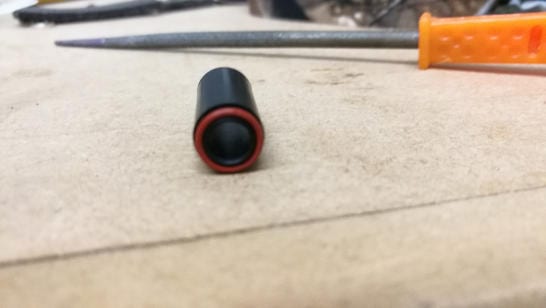
Section 2D – Piston Mods:
Airbrake – The airbrake is something I’ve been doing on my rifles for years and was a key design in the WASP series of pistons I’ve been working on. What this does is greatly reduce the sound of the rifle, but slowing the piston down at the end of it’s travel and essentially restricting how fast the air flows though the cylinder head.
This causes a drop in power on light ammo, but has a neglibable effect on heavy weight ammo, the idea being that slower/gradual air release allows for a longer (albeit we’re talking hundreths of a second) release of air. When paired with a heavy piston this combination works great, though isn’t always suitable for super high joule builds, the benefit of the airbrake (in my WASP atleast) is that you shotr shorten the airbrake and change the diameter, so you can tune it for your personal preference.
.
My current working theory on this is that there is a slight delay before the BB grips the hop up, especially when the air is delivered fast and abruptly, however when an airbrake is introduced, you slow this down, easiest way to explain it is a car pulling of the starting line, to much apower and it skids, energy is wasted and there is little grip, leading to a false start, by slowing this down you increase the torque and in THEORY you grip better. This is a working theory and something I’ve been looking into a while.
Easiest way to install the airbake on a standard piston is to drill a small hole (possibly thread) and insert a plastic rod which is cut to fit.
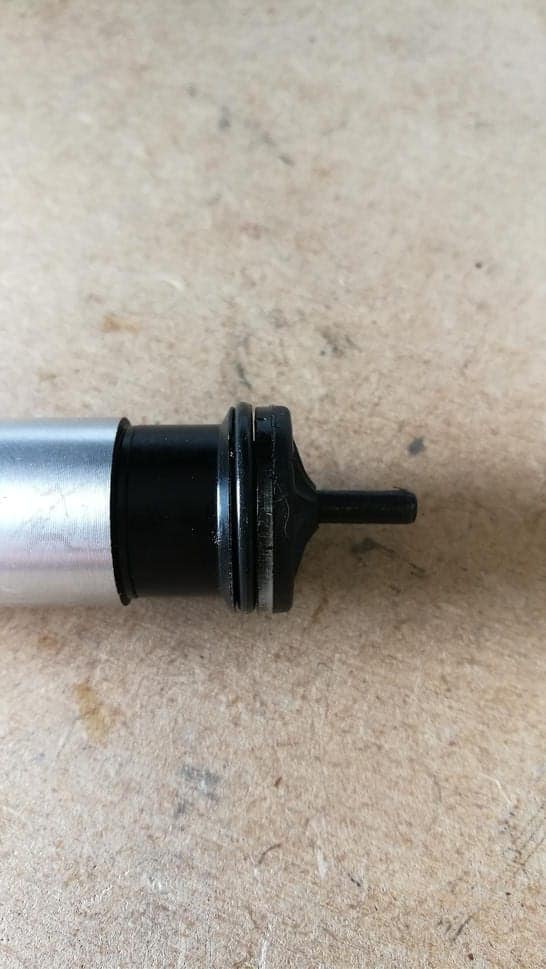
Weighting – Adding weight to a piston increases joules on heavy ammo, simply reason for this is the piston accelarates slowly and the air is more gradual, coupled with the added weight (this only works up to a paint and varies on a number of factors), more energy is transferred to the BB while it is accelerating down the barrel. Another result of this, is lowered FPS on light ammo.
Ways to add weight to a stock piston include, wrappig soldering wire around the piston and securing with tape, using lead tape from a golf store, or cutting aliminium/steel rods to fit over the piston, this one requires you to remove the lug at the rear of the piston.
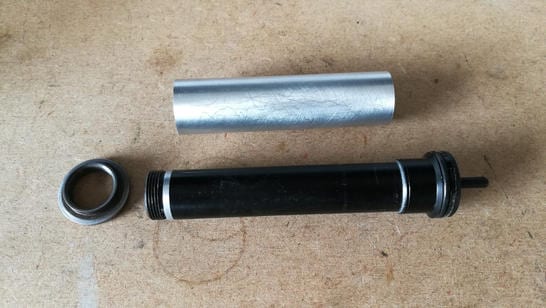
Section 2E – Loose Mag Effect
Opening the body up slightly at the front and rear of the mag well to enable a mag drop mag change. Apply some glue or weak thread lock to the bolt threads to prevent them becoming undone in a game.
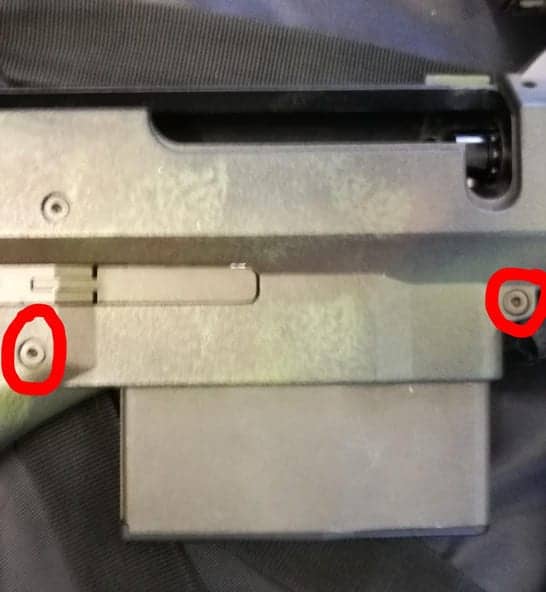
Some mags may have feeding issues with this as they drop down at the front, to fix thses individual mags, you can remove the plastic inner and “spread” the steel shell at the front narrow area. The mags can also become squashed in pouches when going prone.
IMG Mag
Section 3 – Upgrades
This section covers some of the main upgrades available for the SRS platform, all of which have been tested by myself, team mates and fellow techs.
Section 3A Barrels:
Due to the high air volume available with the SRS, I personally suggest that wider barrels are used. 6.03-6.1, this will also depend on the length of barrel that you plan to run in your rifle.
Barrels that I’ve tested personally which have offered great results have been.
– PDI 6.05
– EdGi 6.05
– Maple Leaf Crazy Jet
– TNT
– ZCI 6.02
– Promotheus
– Maple Leaf 6.02
– EdGi 6.01
While the SRS Stock barrel is certainly one of the better stock barrels available and already comes in 6.05, it’s made of brass and isn’t as high a quality as some of the aftermarket barrels.
Each of the barrels above has it’s own pro’s and cons that I’ve found, which I’ll summarise below. It’s worth nothing that there are many many barrels out there, but this guide is aimed at ones that have been tested and proved to have good results:
PDI 6.05/6.08
Pros – great quality, the 6.05/6.08 size performs well, works great will normal style buckings
cons – Not the cheapest barrel, has a small hop window
EdGi 6.05
Pros – Outstanding quality, nice wide hop window, 6.05 size works well at range
Cons– Still made of brass so can be damaged if screws are over tightened, one of the most expensive barrels
EdGi 6.01
Pros – Outstanding quality, nice wide hop window, 6.01 gives great accuracy up to a point, but suffers at range as the gun is massively overvolumed and the amount of air release is to aggressive and causes a loss of accuracy at range.
Cons– Still made of brass so can be damaged if screws are over tightened, one of the most expensive barrels. Bore is to tight for a high volume setup.
Maple Leaf Crazy Jet
Pros – the design of the barrels with their porting works very well, the bore is wider than 6.03, cheap compared to other brands, works well with the SRS hot shot bucking, TNT, Super, Rhop etc
Cons – Still made of brass so can be damaged if screws are over tightened, slightly harder to cut Rhop patches for.
TNT
Pros – Works extremely well, I personally run one of these in my Gspec setup, offers a very flat and consistent flight path due to redesign, the bore drops from 6.03 to 6.35 at the end of the barrel.
Cons – They are one of the more expensive barrels, hop window is slightly harder to cut patches for, due to the wider bore, a slight drop in joules is expected I lost .2J on 48’s.
ZCI
Pro – Very cheap barrels, come in a variety of sizes and have good hop windows, quality is good for the price.
Cons – They are 6.02 which is a bit tight for something which such a high air volume, they work well in the longer variants, QC can be hit and miss on some batches.
Section 3B – Hop Rubbers
In terms of hop buckings for the Silverback SRS, you really are spoilt for choice, there are many many combinations that work very well. I’ll cover the ones that are tried and tested below in order of maximum performance VS ease of install, alongside the chamber they work best in.
IMG Buckings
Stock Silverback SRS Bucking – This standard bucking in the standard chamber works very well and for the average user will be than adequate at meeting their performance expections. It works well, it’s consistent, hos heavy ammo and when airseal mods are done, gives a great seal. This also works well in the FAST hop chamber when paired with a good nub.
Poison Apple Bucking – Now this bucking is a cheap one found readily online and works great both in the stock chamber and in the FAST hop when paired with a good nub, which will be covered in section X. For it’s price and ease of setup, it’s a great drop in choice for a decent performance increase.
TruHop Bucking – This simple Rhop like drop in bucking works extremely well, but does require the use of barrels with wide windows, so not perfectly suited to PDI ones. the bucking is soft so care needs to be taken when installing to avoid tears. once set up the bucking offers great range and accuracy, at the cost of a slightly weaker airseal. This works in both chambers, but best results for me have been in the TNT/maple Leaf barrels with the FAST hop chamber and Prowler nub.
Maple Leaf SRS HotShot – The new bucking, is an upgraded version of the existing HotShot bucking, specifically designed for the Silverback SRS. This bucking allows the use of Maple Leaf Crazy Jet barrelsin the SRS and offers a great seal, able to easily hop 48’s once set up. This only really works well in the FAST hop chamber, with the Tigra/Prowler/Omega nub.
Maple Leaf Super/Wonder Bucking –
Oddly the maple Leaf Super/Wonder buckings fit into the FAST hop chamber with a bit of lubricant and some patience. Depending on your setup, if you’ve modded the nozzle etc, there have been some good results using these rubbers with the Omega nub, Prowler and Tigra Nubs.
Rhops
-Rhops when done properly are very very effective and can give outstanding performance. These can work well in both the FAST hop and the stock unit. In the FAST Hop unit you will need to use a nub, the best ones currently available in my opinion and based on my tests are the Prowler/Tigra nubs or a custom Mnub, depending on the size of your barrel window.
With the Rhops there are a few options out there, the main ones that I’ve tested and used included Silent Sniper Rhops, Stalker Rhops and just ones that I’ve cut myself. I PERSONALLY avoid any “moulded” rhops, unless they are RTV/Sugru hops that you’re confident doing yourself. But that’s because I’m a tinkerer, however people can/do have good results with them.
With the Rhop patches, they will need to be drop ins/Cut for specific barrels due to the differences in wind widths, heights and angles of the leading and trailing edges.
For the Rhop you will need a suitable bucking for the airseal, the most common ones used are the Modify Black/Modify Grey flat bucking, Poison Apple, Stock Bucking. the last 2 need to be modded with the mound removed.
Moulded Hops (Sugru/RTV) – These patches are DIY only and require you to make your own mixture and mould it to the shape of you window, allow it to set and then tidy it up. They are suitable for both hop chambers, but again, in the FAST hop they work well with the TIgra/Prowler nub/Mnub. The most common method is using Sugru, which is an old mod now where you use the material to form an Rhop patch in your window, by using a 6mm tube inside the window, adding the Sugru/RTV to the window and shaping it to the exact window size, then leaving to set and tidying up any access when finished. As with the Rhop, this required the use of a bucking for the seal. Sugru tutorials are widely available online and for the RTV mods, “The Gray Fox” on facebook has some great tips.
TNT TR-Hop – These new rubbers from TNT are similar to the Truhop buckings in that they come complete with a moulded Rhop patch, they come in 50-70 shore and from my testing (currently running a 50 degree in my SRS with modded prowler nub and TNT 300mm barrel), they can work extremely well. They fit the stock barrel, Maple leaf, TNT and with some patience even the PDI barrels.
Section 3C – Nubs (FAST Hop Chamber):
Depending on the barrel and hop setup you’re using, you will want to use different nubs.
IMG Nubs
For me personally I swear by the Tigra/Prowler nubs from Stalker Airsoft. I originally used FOW/SCS/H style nubs for a while and performance with them was good, but since moving to the Stalker nubs, I wouldn’t go back, which is not to say some people haven’t got great setups with the alternatives available. The FOW nub works very well with standard mound buckings like the Poison Apple and stock SBA bucking, others have reported good results in Rhop setups, but from my experience, they gave good accuracy but was a fine line between hopping and jamming.
Another common nub which works well once set up is the standard Maple Leaf Omega nub, great for the Maple Leaf buckings and Rhops. It requires a bit more care to install properly and keep centred, but once done does work well and is a cheap nub.
The TNT T-Nub is another good alternative, it requires a bit of trimming for the hop arm to fit over it, but offers a long concave contact area.
The FAST hop chamber takes any kind of AEG nub essentially, however there is a large gap either side of the hop arm, which in some cases can cause the nub to shift, resulting in curve shots. As with AEG/VSR chambersm you can resolve this with shimming.
Section 3D – Piston:
Piston wise, for the sake of this guide, we’ll assume everyone is using the Pull bolt system. In which case there are 2 types of commercially available pistons which is the stock Pull bolt Piston and then the lightweight piston. long story short here, stick with the stock and slightly heavier Pull Bolt Piston as it’s gives the best performance in terms of Joules.
There is another piston available which is a copy of the existing SRS piston, but made of a different material to increase weight, this requires the use of the piston head and sear from your original piston, in order to remove these you will need a lot of heat and strength as they are fixed on very securely as people have found out.
As a placeholder, I have been working on the SRS W.A.S.P for some times and it’s in final stages of testing before commercial release.
There is also an SRS upgrade kit from EdGi Custom works, however I have yet to test this so it wouldn’t be fair of me to comment. Quality wise you can expect this to be good as it’s EdGi. how much of an improvement over the standard/modded parts has yet to be seen.
Section 3E – Spring Guide:
Again, at the moment the only commercially available Spring guide is the Silverback SRS Teflon coated bearing spring guide. This does offer a slightly smoother bolt pulll over the stock one, but in my experience it was louder and the shot to shot FPS consistency decreased, albeit marginally.
IMG Spring Guides
The SRS WASP kit also comes with it’s own upgraded spring guide to work in unison with the WASP piston.
Section 4 – Externals:
Externals wise for the SRS you’re once again spoilt for choice for what you can do with the platform.
Section 4A – Suppressors
Suppressor wise the Silverback DTSS suppressors are extremely good, whether it’s the .308 or the .338, they both are designed very well and work great. They are designed to fit on the 24mm x 1mm CW threaded rifles or the Silverback DTSS muzzle break.
There is a 24m x 1m to 14mm CCW adaptor available which allows the use of normal size airsoft suppressors on the rifle. It’s worth noting that the Silverback SRS 16″ covert model comes with it’s outer barrel threaded the 14mm CW already.
Due to the high air volume of the SRS, wider/longer suppressors work well, the longer variants of the SRS can be deadly silent with a basic no thrills suppressors. That being said, with a few mods the Gspecs can be quieter than an M23!
Section 4B – Triggers
The guys at Silverback Airsoft have released some awesome triggers for the SRS rifle, which come in 3 main styles.
The Sport:
IMG Sport
The Match:
IMG Match
The Speed:
IMG Speed
While these add nothing in terms of actual performance, they do look and feel great, I run the Match trigger on mine and the dual stage does in fact feel great and offer a nice tactile sensation.
These triggers are preload adjustable and can also have the safety hold adjusted with a grub screw.
Section 4C – Outer Barrels
There are a lot of outer barrel options for SRS, ranging from the main standard lengths, to lightweight carbon fibre barrels, even fluted and Bull variants.
16” tapered – 420mm Inner – 14mm CCW Threaded
18” tapered – 470mm Inner – 14mm CCW Threaded
20” Sport – 510mm Inner – 24mm x 1mm Threaded
22” bull – 590mm Inner – No Thread
22” fluted – 578mm Inner – 14mm CCW Threaded
26” fluted – 680mm Inner – 14mm CCW Threaded
455 mm carbon – 455mm inner – No Thread
590 mm carbon- 590mm inner – No Thread
650 mm carbon- 650mm inner – No Thread
G-Spec bull – up to 309mm Inner – 24mm x 1mm Threaded
On interesting thing that can be done with the Carbon Fibre outer barrels and sport barrels (inner diameter is the same, and barrel spacers are compatibles), is that you can internally suppress them with and run a short inner barrel. I’m working on one of these at the moment, so will add it to this guide once done 🙂
Section 4D – Hand guards
There are only two rail sets which are available at the moment, which is the standard short rail (AKA Covert) which comes with the 16″ Covert and the 20″ Sport, plus the long rail which comes with the 22″ and 26″ variants.
Not really a hue amount to add really, it comes down to personal preference more than anything else and what outer barrel you’ll be using. I’ve seen some rifles running a 22″ outer and a short rail and they look pretty good!
You also have the possibility to remove the handguard and use the receiver thread protection provided with the G-Spec kit.
Section 5 My Main Setup –
My current setup (I say current as the rifle is always in pieces testing parts and ideas) is as per the below:
Base Rifle – SRS 16″ covert, converted to Gspec kit
Spring – Currently an SBA m150
Spring Guide – WASP
Piston – WASP with 79g weight and airbrake
Hop Chamber – FAST Hop
Bucking – TNT Tr-Hop 50 Degree
Nub – Prowler V1
All the sound mods as per the above, nub removed on cylinder head etc
Joules are 2.3J on 48.s and 1.8J on .2,s.
Effective range (hit more than miss) is circa 85/90m
I also occasionally run the original 16″ covert outer and rail, with a FAST hop unit, with PDI 420mm 6.05, TNT TR-Hop 50 degree, V1 Tigra nub
Plus a 650mm Carbon Fibre Outer with a 470mm Maple Leaf Crazy jet, Stock Chamber and 60 degree maple Leaf SRS HotShot Bucking.
Section 6 – Overall Thoughts
For me the SRS is a great platform, while it’s an expensive purchase, you really are paying for quality, the construction of the rifle is great, it has an easy takedown process for field disassembly and he a reasonable amount of aftermarket support, with new people/companies releasing items.
In terms of how they perform, it really depends on the setup and parts combination of the rifle. Due to the rifles high cylinder volume it works very well on heavy ammo and even at the 1J limit they still have considerrange when upgraded.
As someone who owned and worked on nearly every rifle going, the Silverback SRS is certainly up their as one of my favourites, my current Gspec setup works well for me and suits my needs, being able to strip it in a few minutes is a great benefit for me when it comes to testing and working on them.
Links:
For SRS upgrade parts and accessories: Empire Airsoft
